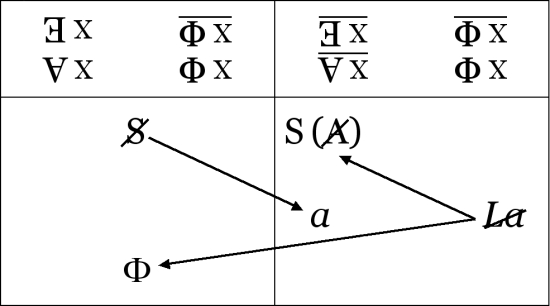Formulae of sexuation
In the seminar of 1970-1 Jacques Lacan attempts to formalize his theory of sexual difference by means of formulae derived from symbolic logic.
The diagram is divided into two sides: on the left, the male side, and on the right, the female side.
The formulae of sexuation appear at the top of the diagram.
Symbolic Logic
"E" stands for the existential quantifier.
Existential quantifiers are used in logic to denote finite collections and can be read as "there exists."
By contrast, "V" denotes (stands for) universal quanitifiers.
"Phi" stands for the phallic funciton.
The Male Side
Upper Level
On the male side of the diagram we have the following.
The formulae on the male side are  .
.
 can be read as "there is a form of jouissance that is not subject to castration."
can be read as "there is a form of jouissance that is not subject to castration."
 can be read as "there is at least one x which is not submitted to the phallic function]]."
can be read as "there is at least one x which is not submitted to the phallic function]]."
---
In Freud's myth of the primal father in Totem and Taboo, the primal father exemplifies this proposition as he has no limits on his sexual enjoyment.
That is, not only can the primal father enjoy all the women of the trible, he can enjoy his own mother and daughters as well.
There are no limitations on his enjoyment.
Lower Level
![]() can be read as "all of a man's jouissance is phallic jouissance. Every single one of his satisfactions may come up short.[1]
can be read as "all of a man's jouissance is phallic jouissance. Every single one of his satisfactions may come up short.[1]
---
The idea here is that all jouissance is mediated in the symbolic such that it is experienced as coming up short or lacking in some way.
Every time I get a bit of recognition, I experience this satisfaction as less than expected or as coming up short.
The jouissance I actually obtain is less than the jouissance I actually expected.
As Fink writes, "There is a barrier between my desire for something as formulated or articulated in signifiers (S) and what can satisfy me. Thus, the satisfaction I take in realizing my desire is always disappointing. This satisfaction, subject to the bar between the signifier and the signified, fails to fulfill me-- it always leaves something more to be desired. That is phallic jouissance. Just as one cannot take the lack out of Lacan, one cannot take the failure out of the phallus."[2]
The abstractness of the signifier-- if that's a good way of putting it --is always in conflict with the concreteness of jouissance, such that each concrete jouissance we obtain is experienced as not being it.
More fundamentally, I experience myself as limited or lacking, as constitutively incomplete.
---
Now here's the key point:
The upper level and lower level of the masculine graph of sexuation must be read together to signify a particular deadlock within the masculine form of relating to jouissance.
Masculine Fantasy
Let the upper portion of the graph be a specifically masculine fantasy of complete or total jouissance.
It is because a man believes either that
a) total jouissance is possible through some action or object, or
b) that some other person or being has total jouissance, that he comes to find all the jouissance that is available in his day to day life insufficient.
--
As one can sense palpably in the clinic, those subjects that occupy the "masculine" position with respect to jouissance, are tormented by the unconscious belief that somewhere, somehow, an uncastrated or complete form of jouissance is possible.
As a result, all jouissance that is actually available to these subjects turns to shit or loses its ability to satisfy.
The result is that masculine sexuated subjects will often concoct fantasies of how to acheive this jouissance and then do everything in their power to prevent actually acting on their fantasies (as they would then be disappointed once again).
Courtly Love
As Lacan puts it in the context of courtly love, "It is a highly refined way of making up for the absence of the sexual relationship, by feigning that we are the ones who erect an obstacle thereto."[3]
In courtly love the man admires the woman from afar, while the woman pretends to ignore the man.
Generally the woman is married or perhaps a nun, so the two are prevented from ever consummating their love.
Perhaps they send pages and pages of beautiful correspondance to one another, bemoaning their inability to consummate their passion, but the whole point is to avoid passing to the act so as to sustain the belief that complete jouissance exists and discovering, once again, the disappointment of phallic jouissance.
--
The Female Side
The formulae on the female side are ![]() (= there is not one x which is not submitted to the phallic function) and
(= there is not one x which is not submitted to the phallic function) and ![]() (= for not all x, the phallic function is valid).
(= for not all x, the phallic function is valid).
The last formula illustrates the relationship of woman to the logic of the not-all.
The Sexual Relationship
What is most striking is that the two propositions on each side of the diagram seem to contradict each other:
"Each side is defined by both an affirmation and a negation of the phallic funciton, an inclusion and exclusion of absolute (non-phallic) jouissance."[4]
However, there is no symmetry between the two sides (no sexual relationship); eahc side represents a radically different way in which the sexual relationship can misfire.[5]
See Also
References
- ↑ Fink, Bruce. p.160
- ↑ Fink, Bruce. p.160
- ↑ 69
- ↑ Copjec. 1994. p.24
- ↑ Lacan, Jacques. Le Séminaire. Livre XX. Encore, 1972-73. Ed. Jacques-Alain Miller. Paris: Seuil, 1975. p.53-4
